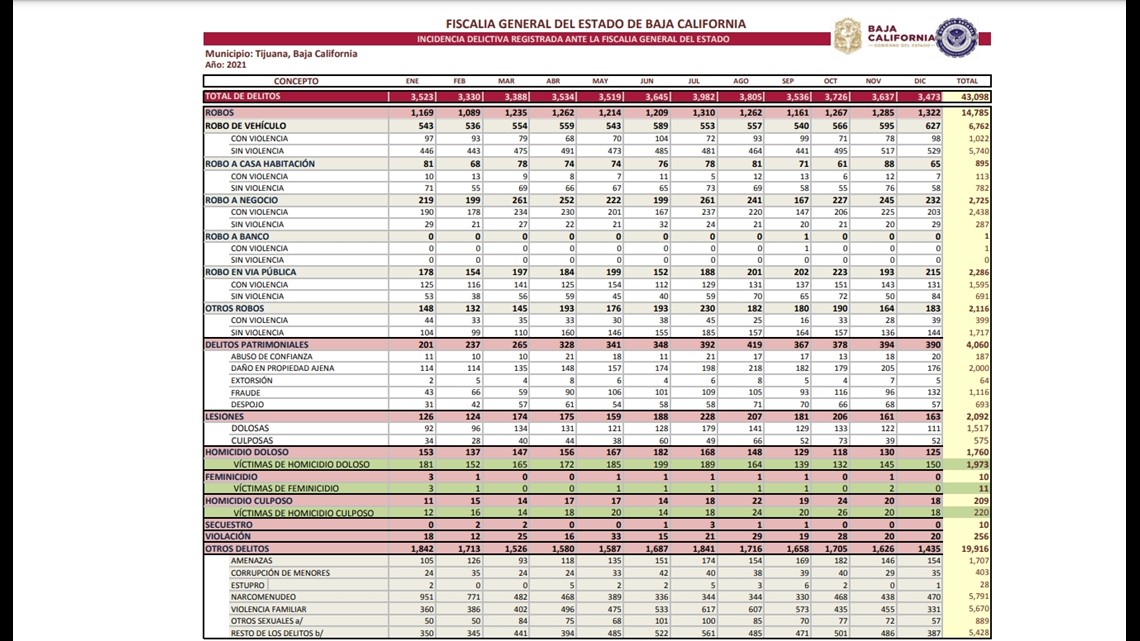BAJA CALIFORNIA SUR, Mexico — Baja California has always been a tourist destination for San Diegans and those visiting the area.
“I’m going for my birthday, we're going to shop and eat at some of the amazing restaurants,” said Jenny Casas, a Chula Vista local.
It's the rich Mexican culture that has historically driven young crowds to flock to the beaches in Rosarito or to the historic Avenida la Revolución, in Tijuana. However, this year, the beaches seem empty.
Three weeks ago, the U.S. State Department issued a travel advisory for Baja California based on the recent crimes and kidnappings, causing some tourists to reconsider travel plans.
For those living in Baja California, the issues surrounding high crime rates are nothing new, especially crimes against women. The worst of those crimes are gender biased killings towards females, called 'femicide' and they have been on the rise for years.
Here is a link from the World Health Organization explaining what is a femicide.
“They call it femicide because it's an attack on women, but it's mainly because of how gruesome the crime is against a female,” said Michael Lettieri who has a Ph.D Senior Fellow for Human Rights, Center for U.S. Mexican studies.
According to the State Attorney General in Tijuana, there have been three femicides, but news outlets, like La Jornada, report 15 women have been killed just in March and adding that in brings the total number of femicides in Tijuana to 44 in 2022.
These are the seven factors that determine whether it is considered a femicide, according to the State Attorney General's website:
The crime of femicide is committed by a person who deprives a woman of life for reasons of gender. It is considered that there are gender reasons when any of the following circumstances occur:
- The victim presents signs of sexual violence of any kind
- Inflammatory or degrading injuries or mutilations, before or after the deprivation of life or acts of necrophilia, have been inflicted on the victim
- There are antecedents or data of any type of violence in the family, work or school environment of the perpetrator against the victim
- There has been a sentimental, emotional or trust relationship between the asset and the victim
- There are data that establish that there were threats related to the criminal act, harassment or injuries of the perpetrator against the victim
- The victim has been held incommunicado, whatever the time prior to the deprivation of life
- The victim’s body is exposed or displayed in a public place
“It's not affecting U.S. citizens, but they are recognizing that this is a horrifying problem happening across the country,” said Lettieri.
One of the recent victims was 19-year-old Elizabeth Soltero, who was found dead in Playas. That same day, another woman was found dead in Tijuana according to recent news articles in Mexican newspapers. Yet, many believe that with unreliable data, the number of femicides in Mexico is likely significantly higher.
Almost 35,000 people were murdered in 2019, Mexico’s most violent year on record. The sky-high murder rate in the country made international news and called into question President Andrés Manuel López Obrador, according to Center for Strategic and International Studies.
While murders in Mexico slightly dropped in 2021, falling 3.6% from the previous year, femicides rose, according to preliminary government data.


The drop in murders is a win for President Andres Manuel Lopez Obrador, who took office in late 2018 pledging to bring down record levels of violence plaguing the country.
Some experts attribute some of the killings to drugs and sexual assault, but there are other reasons.
There’s been a shift where a lot more patterns of violence in Mexico are connected to domestic drug dealing,” said Lettieri.
Still, Lettieri explains that’s not the argument, "women are not saying they demand justice from the cartel, they want justice from the state.”
Immigration advocates say this violence is rooted to machismo culture and urge the government to do more to protect women.
“It’s this whole issue of impunity, so many mothers who have not received answers from the government about their missing daughters. So it’s not only men that are murdering women, but also the lack of accountability. The government is not bringing justice to these cases, instead they are ignoring it,” said Dulce Garcia, the Executive Director for Border Angels.
Only recently has Mexico begun counting data for femicides, but femicides first began to draw attention back in early the 1990’s.
“Mexico as a country has been ignoring women and the life of women. There are truly hate crimes, and it's horrifying to hear that it's been ignored for so long,”said Garcia.
During International Women’s Month in March, a feminist movement took to the streets across Mexico and in Tijuana, hoping to draw attention to femicide.
Women carried signs that said: “I march because I'm alive and I don't know for how long."

